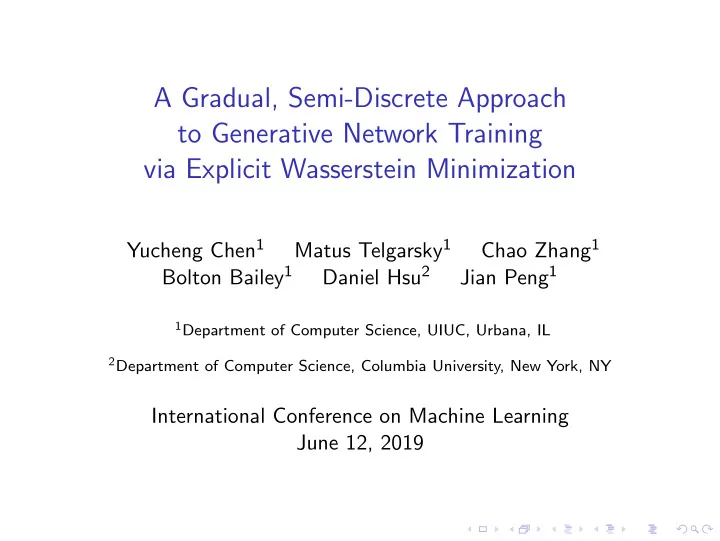

A Gradual, Semi-Discrete Approach to Generative Network Training via Explicit Wasserstein Minimization Yucheng Chen 1 Matus Telgarsky 1 Chao Zhang 1 Bolton Bailey 1 Daniel Hsu 2 Jian Peng 1 1 Department of Computer Science, UIUC, Urbana, IL 2 Department of Computer Science, Columbia University, New York, NY International Conference on Machine Learning June 12, 2019
Explicit Wasserstein Minimization ◮ Goal: To train a generator network g minimizing the Wasserstein distance W ( g # µ, ν ) between the generated distribution g # µ and the target distribution ν , where µ is a simple distribution such as uniform or Gaussian. – Indirectly pursued by WGAN (Arjovsky et al., 2017) ◮ Motivation: If the optimal transport plan between g # µ and ν can be computed, why not use it to explicitly minimize W ( g # µ, ν ) without any adversarial procedure?
Key Observations In the “semi-discrete setting”, where g # µ is continuous and ν is discrete (denoted as ˆ ν ), 1. W ( g # µ, ˆ ν ) is realized by a deterministic optimal transport mapping T between g # µ and ˆ ν , and 2. fitting the generated data g # µ towards the corresponding target points T # g # µ may lead to a new generator g ′ with lower Wasserstein distance W ( g ′ # µ, ˆ ν ). An algorithm iterating these two steps (called as “OTS” and “FIT”) would explicitly minimize W ( g # µ, ˆ ν ).
A Synthetic Example FIT FIT OTS OTS OTS FIT FIT
The Algorithm ◮ OTS: Compute the semi-discrete optimal transport between g # µ and ˆ ν by minimizing (Genevay et al., 2016) N ψ i ) d g # µ ( x ) − 1 � i ( c ( x , y i ) − ˆ � ˆ min ψ i . − N X i =1 and the Monge OT plan is given by T ( x ) := y arg min i c ( x , y i ) − ˆ ψ i . ◮ FIT: Find a new generator g ′ by minimizing � c ( g ′ ( z ) , T ( g ( z ))) d µ ( z ) . z ◮ Overall algorithm: Iterate OTS and FIT.
Experimental Results ◮ MNIST: Better visual quality, better WD/IS/FID (even with small MLP architectures!) ◮ CelebA/CIFAR: Worse visual quality, but still lower WD ◮ Lower Wasserstein distance does not always lead to better visual quality: importance of regularizing discriminator in GANs (Huang et al., 2017; Bai et al., 2019).
References Mart´ ın Arjovsky, Soumith Chintala, and L´ eon Bottou. Wasserstein generative adversarial networks. In ICML , 2017. Yu Bai, Tengyu Ma, and Andrej Risteski. Approximability of discriminators implies diversity in GANs. In ICLR , 2019. Aude Genevay, Marco Cuturi, Gabriel Peyr´ e, and Francis R. Bach. Stochastic optimization for large-scale optimal transport. In NIPS , 2016. Gabriel Huang, Gauthier Gidel, Hugo Berard, Ahmed Touati, and Simon Lacoste-Julien. Adversarial divergences are good task losses for generative modeling. 2017. arXiv:1708.02511 [cs.LG] .
Thank you! Poster: Pacific Ballroom #4 6:30PM, Jun 12
Recommend
More recommend